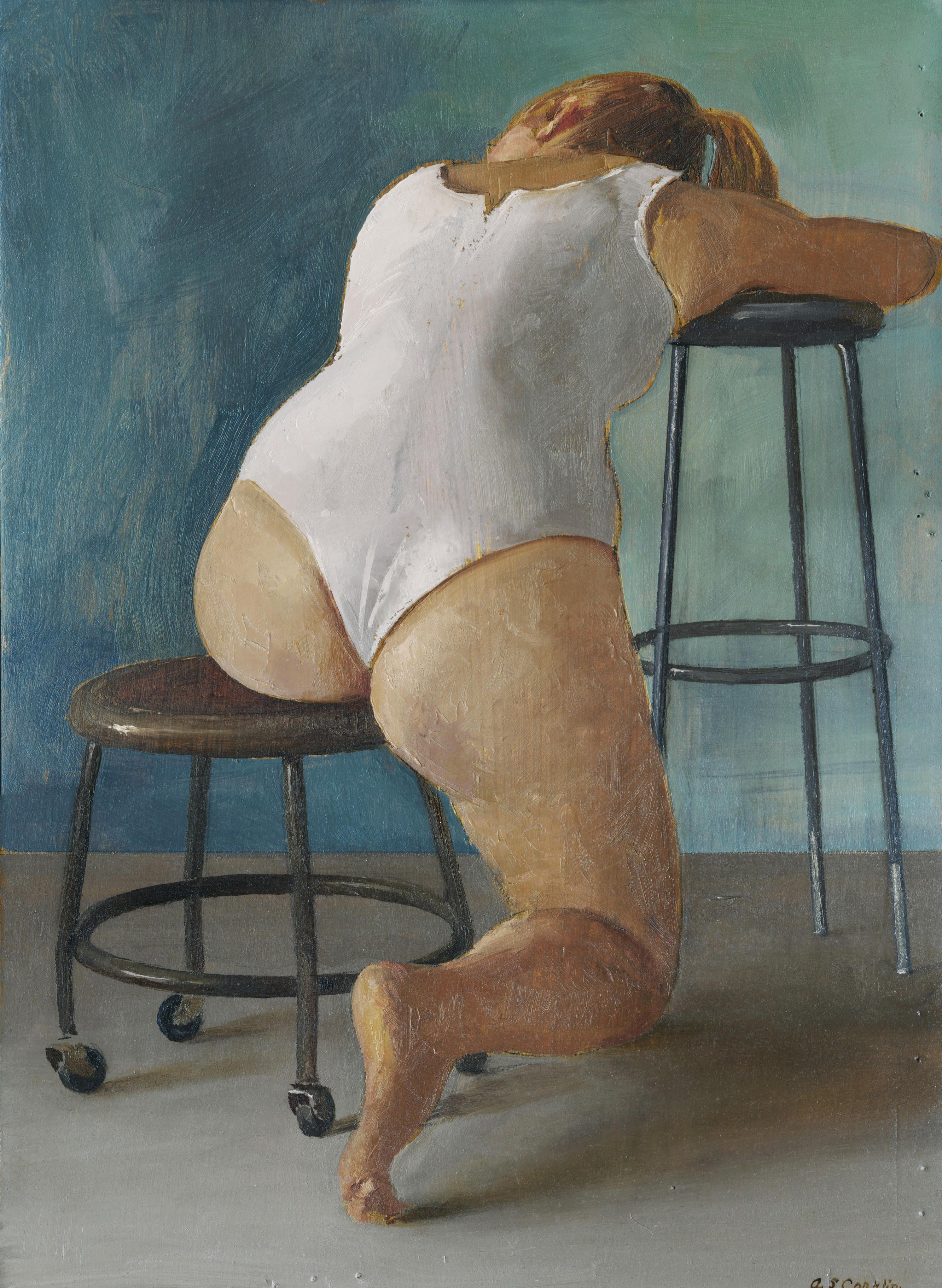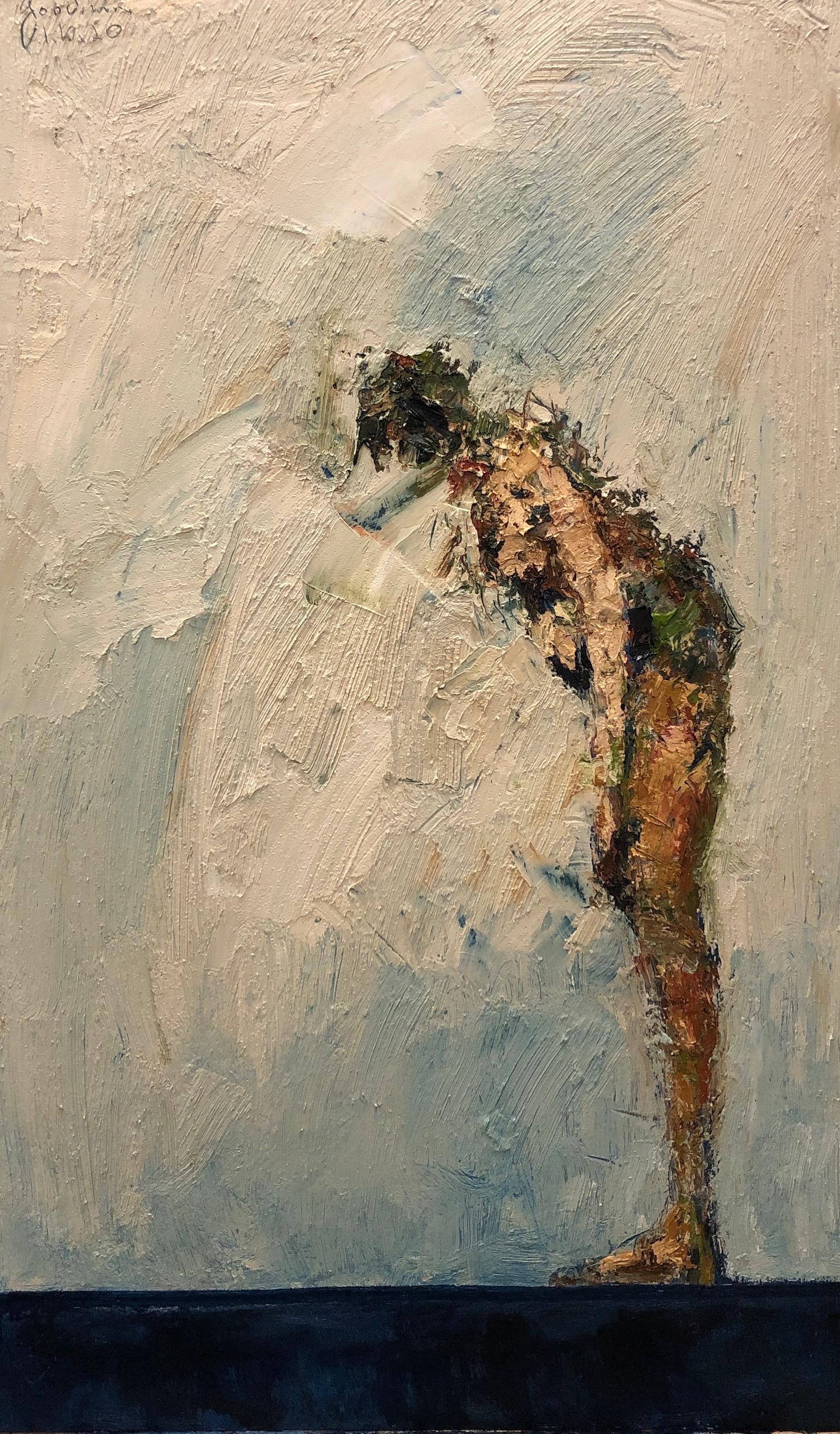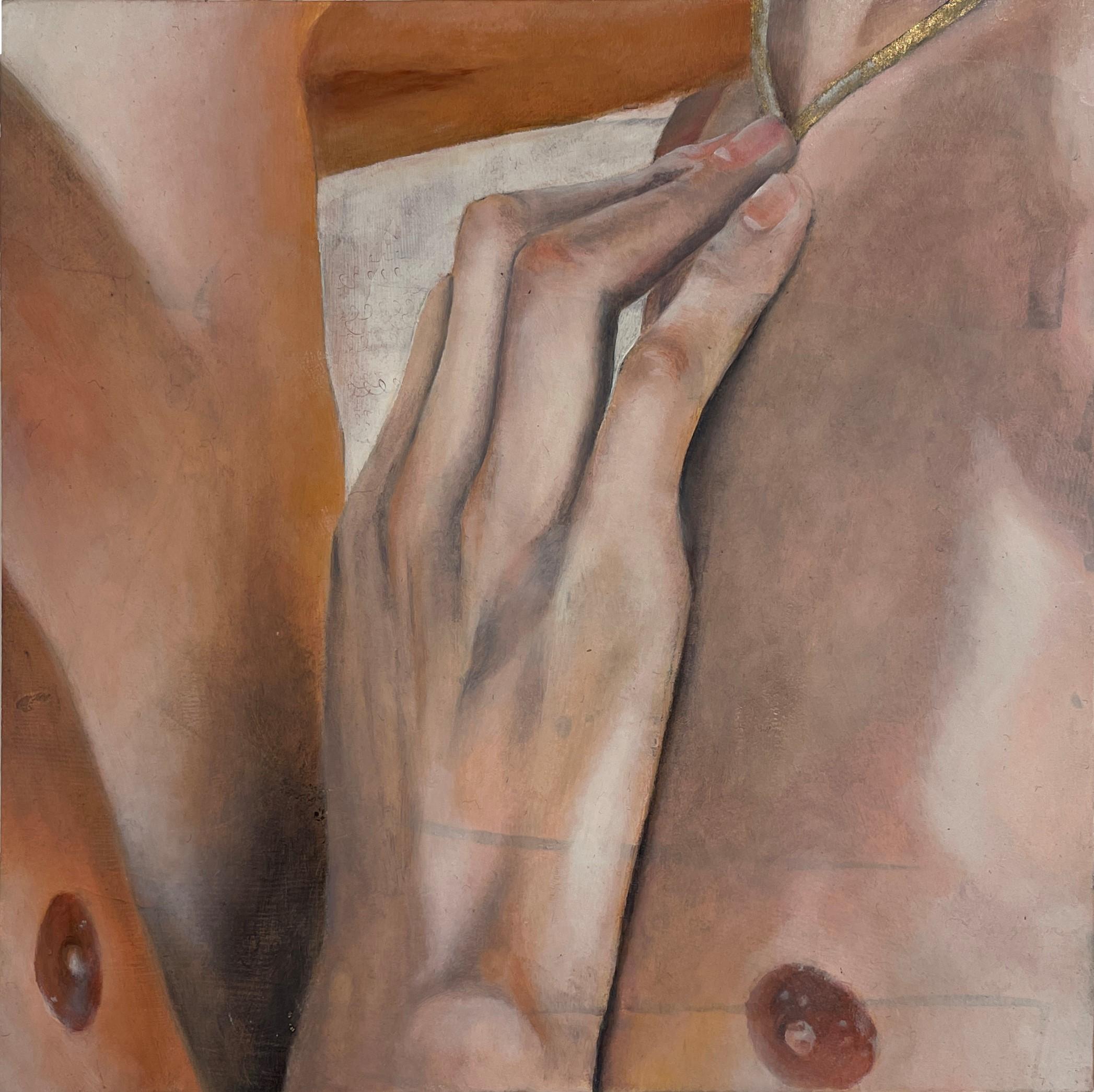Items Similar to Femme dan les sous-bois, 19th Century Adolphe MONTICELLI (1824-1886)
Want more images or videos?
Request additional images or videos from the seller
1 of 10
Femme dan les sous-bois, 19th Century Adolphe MONTICELLI (1824-1886)
About the Item
Femme dan les sous-bois, 19th Century
attributed to Adolphe MONTICELLI (1824-1886)
Large 19th Century French impressionist woodland scene of nude females, oil on canvas Adolphe Monticelli. Excellent quality and condition, labelled verso and presented in its original handmade gilt pierced frame.
Provenance: Orangerie des Tuileries, 1953, no. 07 Sheon, Paris
Measurements: 25" x 22" framed approx
Biography
Monticelli entered the Paris studio of Paul Delaroche at the age of 22. His parents initially favoured a career as a pharmacist, but were soon convinced of his artistic vocation, thanks more to their son's complete lack of enthusiasm for any other activity than to evidence of outstanding talent on his part. Adolphe was a relatively undistinguished student during his three years at the municipal school of drawing in Marseilles; his true inspiration was the Louvre, where he spent long hours copying works by Rembrandt, Veronese and Giorgione, and where he met Delacroix, whom he admired throughout his life. He returned to Marseilles from 1849 to 1863, when he settled in the French capital once again until the outbreak of hostilities in 1870.Monticelli's career was divided equally between Paris and Marseilles (he spent a total of 15 years in each). His artistic evolution is marked by clearly distinguishable 'Paris' and 'Marseilles' periods, but his work as a whole remains underpinned by an inexhaustible, lifelong exploration of the physical and expressive, spiritual properties of colour. His early Romantic works (before 1860) are characterised by capable drawing, careful handling and the use of glazes in shades of yellow and red-brown over a bituminous base. A handful of compositions from this period feature a livelier interplay of brighter, purer colours; by 1860, Monticelli's technique had evolved increasingly in this direction. His paintings of the 1860s are characterised by pearly, iridescent effects and a sophisticated palette. His scenes from the Decameron, or fêtes galantes at St-Cloud, convey an exhilarating sense of joie de vivre, luxury and refined pleasure, perfectly in keeping with his 'dandified' persona. Napoleon III acquired two of his paintings, and he enjoyed an enthusiastic following among British collectors. Despite the limitations of his subject-matter and motifs, his painting was consistently fresh and sparkling, never mechanical. Delacroix expressed surprise at Monticelli's success, and admiration: 'There arose around Monticelli a kind of expectant rumour among his fellow painters'. Monticelli himself was untroubled by the views of his critics, whom he did not frequent, or his collectors, since he sold his pictures exclusively through dealers. He was devoid of social or financial ambition, content to sell enough work to support his chosen lifestyle, and never exhibited at the Salon. He was a stylish dresser, a womaniser and a gourmet. His distaste for social scheming may go some way to explain why he was never awarded the usual public honours. In the manner of Victor Hugo's hero Ruy Blas, he nurtured a sentimental, idealised passion for Napoleon III's Empress, Eugénie de Montijo, whose features are discernible in some of his female figures. With the fall of the Second Empire in 1870, Monticelli's dilletante existence in Paris came to an abrupt end. He left his home in Romainville on foot, stayed for a few weeks in the southern French town of Salon and arrived in Marseilles in 1871, now aged 47. Misunderstood, and alienated from local collectors and the city's intellectual élite, Monticelli was forced to work in isolation. In Marseilles - with its tumult and squalor, its sunsets redolent of the Oriental splendors of the Maghreb just over the horizon - Monticelli was free to develop his distinctive, mature style. When peace returned he chose to stay in the south, despite the entreaties of his Parisian friends, living in one room furnished with a low bed, an easel and two chairs. Bathed in purplish light from its only window, hung with a red flowered curtain, Monticelli delighted in his humble lodgings and settled contentedly into a new life of quiet probity, enjoying the company of a handful of local shopkeepers - simple, everyday people, lovers of good food and ritual drinkers of absinthe. He attended the opera and the Italian pantomime, highly popular at the time, and was transported by music of all kinds, especially that of the Hungarian gypsy bands who performed regularly in the city's bars and cafés. 'At the last flourish of the fiddler's bow, he would hurry back to his garret, light all the candles he could muster and paint until he was weak with fatigue.' (Paul Guigou). The correlation between music and images is central to Monticelli's work throughout his final Marseilles period. Like his contemporaries Théophile Gautier and Baudelaire, he seems to have experienced synaesthesia, 'hearing' the melodic properties of colours and light in what became, for Monticelli, a permanently-altered perceptive state. 'The sound of blues and greens reaches me in palpable waves', he observed. This 'musical climate' remains an important factor distinguishing Monticelli's work from the output of his many plagiarisers. His pictures are imbued with the sensory fluency of the Venetian school, mixed with a kind of 'magical realism' (his family were of Venetian origin, and he claimed to have lived in the city in past lives). Upon his arrival in Marseilles in 1871, he abandoned his earlier, virtuoso style in favour of a highly disciplined technique based on three colours: grey, yellow and violet. From 1875 onwards, however, colour flowed back into his work. Contrary to popular belief, he seldom painted with a palette knife, preferring short, hard brushes. His technique and handling are deft and innovative, wiping colours with a cloth, spreading paint with his fingers, using complementary colour contrasts, isolating elements of his composition within heavy outlines, employing bright hatching or dots in 'major' colours against neutral backgrounds. Cut off from the artistic mainstream, Monticelli was free to explore and innovate, off-setting impasto colour against the natural hues of his supports: red-brown mahogany, blond walnut. His prolific output of medium-sized easel paintings embraced flower-pieces, portraits, still-lifes and opera scenes, bathed in the light of the French Midi, bright and warm - Monticelli's light. ('I paint three keys higher...', he noted.) His portraits burn with a strangely fevered light noted by Van Gogh. Unlike many other painters, Monticelli's brand of Impressionism seeks to preserve form, rather than dissolving it in light. 'Monticelli created a new generation of colour, the offspring of light itself', wrote G. Boissy. 'In this, he has no rival'. Monticelli's extraordinary œuvre is peppered with masterpieces, and some notable failures, yet all of his works feature passages of exquisite, visionary quality.Monticelli's work features regularly in thematic exhibitions, such as Women in Provence and the Mediterranean ( Le Femme en Provence et en Méditerranée), organised by the Fondation Regards de Provence at the Château de Borély in Marseilles, in 2001.
Museum and Gallery Holdings
Aix-en-Provence: Ladies in a Park; Landscape; Head of a Ruffianly Soldier
Aix-en-Provence (Mus. Granet): Park Scene (oil on canvas)
Algiers: Woman with a Dog
Allauch (Church of St-Sebastien): Let's Go for Heaven
Amsterdam (Rijksmus.): Jesus among the Little Children; Sunlit Promontory; At the Altar; Woman in a Tailored Jacket; Outdoor Gathering of Ladies and Gentlemen; Elegant Company in a Park; Landscape
Amsterdam (Stedelijk Mus.): Resting in a Forest
Antwerp: Figure in a Park; The Port at Marseilles
Baltimore: Track through the Woods; Allegory (oil sketch); Allegory; Spring Morning; Allegory; Sunset; Portrait of Monticelli
Boston: Scene from Don Quixote; Scene on a Terrace; Landscape
Bowes: Landscape
Brussels: Autumn
Bucharest (Muz. National de Arta al României): Scene in a Park; Portrait of a Woman
Buffalo: Portrait of Madame Rosenthal (attributed); Cardiff: Capers
Dijon: Departure of the Hunt
Edinburgh (Nat. Gal. of Scotland): A Gypsy Encampment (oil/panel); The Fête (oil/panel); The Garden of Love (oil/panel); A Woodland Fête (oil/panel); A Garden Fête (oil?/panel); In the Grotto (oil/panel)
Frankfurt am Main: painting; Scene in a Park
Glasgow: Adoration of the Magi; A Garden Party; A Nuptial Procession
Grasse: Scene in a Park
Ixelles: Seascape
Lille: Scene from the Decameron; Landscape
London (NG): The Hayfield (1860-1880, oil/wood, on loan to the Hugh Lane Municipal Gallery of Modern Art, Dublin, since 1979); 12 paintings from Harry Wearne's collection
Lyons: Portrait of Mme René; Scene in a Park; Bathing-party
Manchester (City AG): A Woodland Glade; Ladies on a Terrace
Marseilles (École des Beaux-Arts): Nude
Marseilles (MBA): Women with Swans; Waterfowl; Portrait of Mme Pascal; Turks at the Mosque
Marseilles (Mus. Cantini): Large Scene with Figures; Group of Figures with Mephistopheles; Riders and Figures; Provençal Landscape; Autumn Landscape (two works); Portrait of a child; Portrait of a Man; Portrait of a Woman; Portrait of M. Kahn
Marseilles (Mus. du Vieux Marseille): Portrait of M. Vincent Torcat
Marseilles (Mus. Grobet-Labadié): Bouquet of Flowers; Travelling Acrobats; Festive Scene in Spain; Faust and Margarete; Sketch; Monsoon; Landscape with Figures; Two Female Nudes; Two Cupids
Milan: Adoration of the Magi
Minneapolis (IA): Garden Scene (Scène de parc) (1868, oil on canvas)
Montreal: Garden Party; An Intimate Gathering; Country Party; Dancing in a Garden; Donkey and Cart
Moscow (Pushkin MFA): Landscape
Mulhouse: Preparing for the Ball; Parrot
New York: Ladies of Quality; Festive Scene
New York (Metropolitan Mus. of Art): The Court of the Princess (La Cour de la Princesse)
Paris (Louvre): Bathers; Strolling at Twilight; Serenade; Still-life; Gathering in a Park; Portrait of Mme Teissier; Women in a Glade
Paris (Mus. des Arts décoratifs): Women in a Glade; Scene in a Park
Paris (Mus. du Petit Palais): Gathering in a Park under the Valois
Philadelphia (MA, Johnson Collection): Masquerade; Nymphs Bathing
Philadelphia (MA, Wilstach Collection): A Boating-party
Pittsburgh (Carnegie MA): The Fountain of Youth (oil/panel)
Portland, ME (MA): Untitled (Landscape with Figures) (Sans titre (Paysage avec figures)) (c. 1880)
Rome: The Return
Rotterdam: Sea Urchins
Roubaix: Gilles the Seducer; A Lady in the Reign of Louis XIII
Sète: Gathering at a Château
St Louis: Arrival of the Guests; Isle of Cythera; Landscape with Figures
Stockholm: Woman with a Fan; Autumn Landscape; Walkers with a Dog; Park scene with Peacocks; Park scene
Strasbourg: Park scene
The Hague (Gemeentemus.): Scene in a Park; Landscape
The Hague (Mus. Mesdag): A Party at Night; Seascape
Toulon: Psyche distributing Cupid's Jewels among her Sisters
Wassenaar: Flowers; Small Dog; Portrait of a Grandfather; Portrait of a Woman; Group of Women
Worcester: Confidences; The Banks of a River
- Attributed to:Adolphe Monticelli (1824 - 1886, French)
- Dimensions:Height: 22 in (55.88 cm)Diameter: 25 in (63.5 cm)
- Medium:
- Period:
- Condition:
- Gallery Location:Blackwater, GB
- Reference Number:
About the Seller
4.8
Platinum Seller
These expertly vetted sellers are 1stDibs' most experienced sellers and are rated highest by our customers.
Established in 2008
1stDibs seller since 2021
201 sales on 1stDibs
Typical response time: 1 hour
- ShippingRetrieving quote...Ships From: Blackwater, United Kingdom
- Return PolicyA return for this item may be initiated within 14 days of delivery.
More From This SellerView All
- The Etruscan Goddess Nortia, 19th Century by George MORTON (1860-1904)Located in Blackwater, GBThe Etruscan Goddess Nortia, 19th Century by George MORTON (1860-1904) Large 19th Century Pre-Raphaelite depiction of the Etruscan Goddess Nortia, oil on canvas by George Morton. E...Category
19th Century Nude Paintings
MaterialsOil, Panel
- Study Of A Male, Possibly as St Sebastian, 16th CenturyLocated in Blackwater, GBStudy Of A Male, Possibly as St Sebastian, 16th Century Early Italian School Oil On Panel Fine 16th Century Italian School Old Master portr...Category
16th Century Nude Paintings
MaterialsPanel, Oil
- Salome With The Head Of St John The Baptist, 17th Century Studio of GUIDO RENIBy Guido ReniLocated in Blackwater, GBSalome With The Head Of St John The Baptist, 17th Century Studio of GUIDO RENI (1575-1642) Huge 17th Century Italian Old Master depiction of Salome w...Category
17th Century Nude Paintings
MaterialsCanvas, Oil
- The Battle of Nördlingen (1634), Thirty Years War, 17th centuryBy Jacques CourtoisLocated in Blackwater, GBThe Battle of Nördlingen (1634), Thirty Years War, 17th century circle of Jacques COURTOIS (1621-1676) Huge 17th century European Old Master of ...Category
17th Century Nude Paintings
MaterialsOil, Canvas
- Sunset Port Landscape, circa 1690 School of Claude LORRAIN (1600-1682) ClaudeBy Claude LorrainLocated in Blackwater, GBSunset Port Landscape, circa 1690 after Claude LORRAIN (1600-1682) Huge 17th/18th Century classical harbour landscape with figures and moored ships at sunset, oil on canvas. Huge and magnificent landscape of an extensive view of the harbour and ancient architecture. Typical of the works of Claude Lorrain. Framed in a 17th Century gilt frame...Category
17th Century Nude Paintings
MaterialsCanvas, Oil
- Nude Boy Bathing, early 20th Century French School - signed indistinctlyLocated in Blackwater, GBNude Boy Bathing, early 20th Century French School - signed indistinctly Large early 20th Century French School portrait of a young boy preparing to bath himself, oil on canvas sig...Category
19th Century Nude Paintings
MaterialsOil, Canvas
You May Also Like
- Paige Seated in White Leotard - Original Oil Painting Study with Female on StoolBy Andrew S. ConklinLocated in Chicago, ILAndrew S. Conklin Artist Statement—Motion Capture Studio Series Andrew S. Conklin, a native of Chicago, Illinois, is a figurative painter. Conklin's paintings are a product of his ...Category
21st Century and Contemporary Contemporary Figurative Paintings
MaterialsPanel, Oil
- "Ornament, " Oil PaintingBy Suchitra BhosleLocated in Denver, COSuchitra Bhosle's "Ornament" is an original, handmade oil painting that depicts a nude blonde woman reclining on a white chaise lounge, her red skirt s...Category
2010s Impressionist Nude Paintings
MaterialsPanel, Oil
- Hercules and Omphale, Old Master Painting, Mannerism, Baroque, Mythology, PragueLocated in Greven, DEHercules and Omphale Oil on panel, 52 x 41 cm According to legend, Hercules had to make atonement and became a slave to the Lydian queen Omphale. When she found out who her slave was, she married him. Falling for his mistress and made effeminate by the luxury of court life, the former hero allowed himself to become the laughing stock of the court. He dressed in women's clothes, spun wool and did other women's work, whereas Omphale wore his lion's skin and carried a wooden club. When the time of punishment was over, the hero realised his delusion and left Omphale. So far, the painting could not be clearly assigned to an artist. Nevertheless, it impresses with its fluid and convincing painting, whose colourfulness and conception are reminiscent of the Prague School around Bartholomäus Spranger. This work follows an engraving and an etching made by Michel Dorigny in 1643 after a design by Simon Vouet. It shows the same scene but the print differs in minor details from the present painting (see e.g. the head of the lion) and the treatment of the faces seems to be painted more detailed and refined. So far there is no painting...Category
17th Century Baroque Figurative Paintings
MaterialsOil, Panel
- Bowing figure no. 1. 2020By John GoodmanLocated in Burlingame, CA'Bowing Figure No. 1, 2020' is professionally framed in simple maple hardwood. The artwork is 30 x 18 inches with the outer frame dimension being 31 x 19 inches. Artist signed, dated...Category
21st Century and Contemporary Contemporary Figurative Paintings
MaterialsWood Panel, Oil
- Figure No. 46, 2011By John GoodmanLocated in Burlingame, CA'Figure No. 46, 2011' by John Goodman. The artwork is 52 x 32 inches.Artist signed and dated. Condition is excelllent. Goodman’s signature restrained palette and impasto brushwork d...Category
21st Century and Contemporary Contemporary Figurative Paintings
MaterialsOil, Wood Panel
- A Quiet Line - Intimate Painting of Two Nude Torsos, Original Oil on PanelBy Rick SindtLocated in Chicago, ILUsing pornography as a vehicle for understanding, Rick Sindt's work explores the discovery and development of queer attraction. Sindt transforms pornographic stills, repurposing them into images of intimacy. Rick Sindt A Quiet Line oil on panel 8h x 8w x 0.50d in 20.32h x 20.32w x 1.27d cm RIS034 “This body of work has been crystalizing in my mind for about five years,” says Sindt, “It is the product of reflecting on how the places I learned the most about myself, and my desires, are considered something that sullies a person, something taboo.” Focused on the experiences of gay men, this body of oil paintings depicts moments that range from tender touches to more sexually explicit acts. “It was important to me that I only represent what I know,” explains Sindt, “I identify as a man, and I am attracted to others who identify as men. I don’t believe it is my place to speak on behalf of other members of the queer community whose experiences I am unfamiliar with.” “In creating this work, I spoke with men who told me about how they hid magazines when they were a kid, took out P.O. Boxes in their small hometowns to protect their privacy, and learned how to cover their tracks on the internet. These secretive acts become necessary when the need to understand yourself is great, but your world is bereft of representation." Rick Sindt b. 1990, Hastings, MN, EDUCATION 2013 North Park University, Chicago, IL - BFA Magna Cum Laude SOLO EXHIBITIONS 2016 Two Countries, Rogue Philanthropy, Chicago, IL 2013 Tides, Erosion or Catch, Pull, Recover; The-One-Right-Now, North Park University; Chicago, IL GROUP EXHIBITIONS 2016 Are We Not of Interest to Each Other, Uptown Arts Center, Chicago, IL Reinventing Ourselves From Another Point-of-View, Contemporary Gallery at Zhou B. Arts Center, Chicago, IL Collective: Process, Beans and Bagels, Chicago, IL 2015 Collective: for(a)ging, Hammond Art Center; Hammond, IN How We Make It, The Arts of Life, Chicago, IL Collective: One, Albany Park...Category
2010s Contemporary Figurative Paintings
MaterialsPanel, Oil
Recently Viewed
View AllMore Ways To Browse
19th Century Paris Chairs
Antique Food Art
Framed Antique Keys
Antique Ladies Chair Chairs
Ladies Antique Chair
Ladies Chair Antique
Nude Dancer Painting
Nude Dancing Painting
Large Female Nude
Party Scenes
Philadelphia 19th Century
Oriental Pictures
Le Louvre French
Children Nude
Nude Children
Large Paintings Walnut
19th Century Rome Painting
19th Century Spanish Paintings





